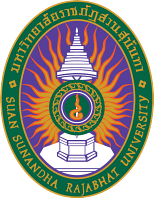Development of learning activities Traditional Flipped classroom and Problem-Based Learning model on plant production in the 4.0 era according to the Sufficiency Economy Philosophy
Keywords:
Learning activities development, Traditional flipped classroom, Problem-Based learning, Sufficiency economy philosophyAbstract
The objectives of this research are to develop a learning activity model that combines traditional flipped classroom and problem-based learning approaches, and to compare the learning achievement and student satisfaction towards the learning activities. The comparison will be made by analyzing the mean scores of two sample groups using an independent sample t-test. The target group consists of 48 third-year secondary school students.
The research findings revealed that students who were taught using the traditional flipped classroom and problem-based learning approaches scored higher on the post-test compared to the pre-test. The average pre-test scores were 15.58 and 16.08, while the average post-test scores were 20.42 and 20.00, respectively. Both teaching methods showed significantly higher post-test scores than pre-test scores at the 0.01 statistical significance level. There was no difference between the two test groups. In terms of satisfaction, students expressed a high level of satisfaction with both teaching methods, with an average score of 4.43 and a standard deviation of 0.70. The flipped classroom model requires collaboration from students in completing assigned activities, as well as the teacher employing an engaging teaching method that emphasizes participation and team working processes. This will ensure the effectiveness of the learning activities and the achievement of the intended objectives.
Keywords: Academic Achievement, the traditional flipped classroom model , the problem-based flipped classroom model (Project Based Learning),
References
Boonchaiyo, K., Hoksuwan, S., & Sichaliew, T. (2019). Flipped classroom learning environment model based on problem-based principles to promote analytical thinking skills for secondary school students. Journal of Education, Mahasarakham University, 13(1), 38–52 (In Thai).
Kuder, G. F., & Richardson, M. W. (1937). The theory of the estimation of test reliability. Psychometrika, 2, 151-160. doi:10.1007/BF02288391
Limwong, T., & Sangrit, Y. (2019). The flipped classroom: A new way of learning for the 21st century. Journal of Mahidol R2R e-Journal, 6(2), 9–17. Retrieved from https://he01.tci-thaijo.org/index.php/mur2r/article/download/241469/164227/ (In Thai)
Maneerat, W. (2012). Development of flipped classroom learning management in chemistry on the topic of acids and bases for students in special science classrooms. In Master's thesis. Srinakharinwirot University . Retrieved from http://thesis.swu.ac.th/swuthesis/Chem/Waratthaya_M.pdf (In Thai)
Ministry of Education. (2088). The basic education core curriculum B.E. 2551: Career education. In Office of Academic Affairs and Educational Standards, OBEC. Retrieved from https://www.obec.go.th
Sanghirun, M. (2010). Statistics for Classroom Research. Journal of Education, Uttaradit Rajabhat University, 19-32. Retrieved from https://shorturl.asia/0LYsB (In Thai)

Downloads
Published
How to Cite
Issue
Section
License
Copyright (c) 2024 Suan Sunandha Rajabhat University

This work is licensed under a Creative Commons Attribution-NonCommercial-NoDerivatives 4.0 International License.
บทความที่ได้รับการตีพิมพ์เป็นลิขสิทธิ์ของ สถาบันวิจัยและพัฒนา มหาวิทยาลัยราชภัฎสวนสุนันทา
ข้อความที่ปรากฏในบทความแต่ละเรื่องในวารสารวิชาการเล่มนี้เป็นความคิดเห็นส่วนตัวของผู้เขียนแต่ละท่านไม่เกี่ยวข้องกับมหาวิทยาลัยราชภัฎสวนสุนันทา และคณาจารย์ท่านอื่นๆในมหาวิทยาลัยฯ แต่อย่างใด ความรับผิดชอบองค์ประกอบทั้งหมดของบทความแต่ละเรื่องเป็นของผู้เขียนแต่ละท่าน หากมีความผิดพลาดใดๆ ผู้เขียนแต่ละท่านจะรับผิดชอบบทความของตนเองแต่ผู้เดียว




